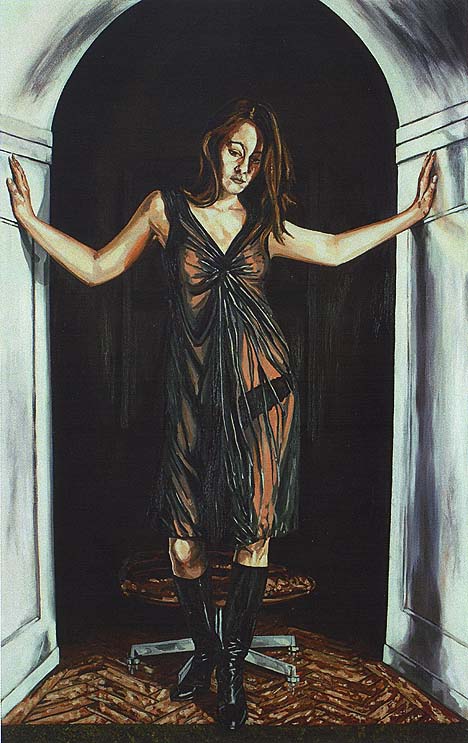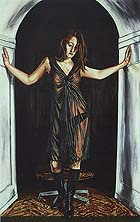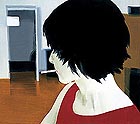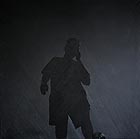
translated and summarized by: Liz Wollner-Grandville,
Summary January 28 - February 1
Museum Frieder Burda: Gerhard Richter - Paintings from Private Collections
Pop and workmanship
It was during Gerhard Richter`s early years: the canvas depicted Vico Torriani surrounded by four young women tasting a new year`s punch in 1962 (reproduced from black and white source material). Obviously the artist was not in the least satisfied with his work and decided to add some more finishing touches. He literally attacked the canvas with a knife, patched up the wounds with a few meagre stitches, poured colour over the backside of the canvas so that it oozed out like blood on the front. Finally he hammered some nails into the ladies shins. He then considered the painting a complete failure and gave it to Günther Uecker to decorate his cellar.
But Frieder Burda had obviously taken to the mistreated celebrities on this early painting of Richter`s as it is now in his possession together with a remarkable number of others. Gerhard Richter has been invited as co-curator of the exhibit in the Frieder Burda Museum and quickly placed his unloved early work where he found it most fitting: in the cellar, close to the toilets.
In the three floors above the basement, 60 collections from important private collections are displayed and offer a look at nearly 4 decades of Richter`s painting. Next to Frieder Burda`s collection you will find works from the Collections Böckmann and Ströher as well as some pieces from Gerhard Richter`s private collection.
Richter`s oeuvre mainly reflects the medium of painting. It is absolutely consequent that pictures taken from magazines, family photographs or from other sources, which are then painted by Richter onto canvas, are led back into the art historical sections such as still life, landscape, history painting or portrait. Gerhard Richter`s work is an unexpected encounter with gestures of pop and German workmanship.
Museum Frieder Burda
76530 Baden-Baden, Lichtentaler Allee 8b, until 27. 04. 08
www.sammlung-frieder-burda.de
Galerie Barbara Preyer: Christopher Leach - Faces
The art of portraiture
From a superficial standpoint one could argue that photography has made portrait painting unnecessary. But artists have always attempted to paint portraits and will most probably always continue to do so - despite photography. After all - the talent to paint a portrait that is not only a pose, but reflects the multileveled facets of a human being, is among one of the most difficult, and rarely successful, endeavours in art.
This exhibit shows the work of a talented artist, who does not attempt to produce zeitgeist art, but consequently translates the theme of classical portraits. However, it is unfortunate that his large oil paintings lack intensity.
The difference in quality between his only recently created pieces, which are shown on the upper floor, in comparison to those on the ground floor, is truly remarkable. This is a good example of how artistic development can become very visible and how important Lucien Freud was as an inspiring example. But in comparison to Freud, Christopher Leach does not manage to let us have a look behind the facades of the faces. We are shown the masks of everyday life, but this too, is definitely art.
Galerie Barbara Preyer
1070 Wien, Breite Gasse 19, until 23. 02. 08
www.youngaustrianart.com
Zacheta Narodowa Galeria Sztuki: Wilhelm Sasnal - Years of Struggle
Politics in everyday life
No other artist of the young generation in Poland is as popular as Wilhelm Sasnal. He is considered as the Polish Roy Lichtenstein, his works being auctioned at Saatchi`s and Sotheby`s for more than 100.000 euros; while Sasnal is only 35 years old. 2006 must have been the highlight of his career: the Italian edition of Flash Art ranked him as the number one among the 100 most important international artists. And in the same year he received the Vincent Van Gogh Award. Many Polish museums regret not to have bought his work sooner - now only very few can afford to do so. His solo exhibit at the Zacheta Gallery in Warsaw was definitely overdue and shows paintings as well as his video art.
Wilhelm Sasnal`s paintings remind of black and white photography. Oftentimes they resemble enlarged comics. Sasnal enjoys using pop colours and compositions, reminding of sentimental as well as atmospheric colour coordination. Everything he paints has a direct connection to what he has experienced, seen, or what he has surrounded himself with. This is the way he wants people to conceive his work. He works with newspaper clippings, articles, videos, photos, and streets. His TV pictures are characterized by a slowed down "replay" effect and are usually zoomed. His choice has no hierarchy: political events are of equal value as personal, everyday happenings. Different themes taken from art as well as art history archives are placed next to one another without any comment.
Sasnal`s films, just like his canvas paintings, are always slightly blurred. Important scenes are exposed to light in such a way that the onlooker has difficulty to identify what he is seeing. "Fall 2006" is a film about the incidents going on in Paris that year. A Super 8 silent movie, effectively done in a way that the blurred technique could let the happenings just as well have been 1986 in Prague or 1965 in Budapest. Sasnal chooses reflections in his personal paintings, as in his political pictures, which go beyond the usual stringing together, application and quotations of different motives, forms and styles.
"Family", one of his more personal works is indefinable; the faces have empty spaces, and they cannot be identified. It is unclear if this painting shows his own family or another family. The technique of the picture allows it to come across as both personal as well as universal. It probably has a lot to do with the fact that Sasnal treats his work equally, no matter if he has painted a friend or a stranger. Thereby political and historical questions are given the same importance as everyday happenings. However, this juxtaposition without hierarchy, seemingly without any values, contains a large potential of criticism. Everything that has changed in Poland and in Eastern Europe is symbolically mirrored in his work: a coexistence of different values, ideologies, fashions, styles, and opinions.
Zacheta Narodowa Galeria Sztuki
00-916 Warszawa, pl. Malachowskiego 3, until 02.03.08
www.zacheta.art.pl
Galerie Jiri Svestka: Rafal Bujnowski, Lamp Black
Secure visual insecurity
Has Modernism succeeded in Poland or has it failed? If Modernism could be defined by ambiguous experiences and diffuse norms and values; that complete renewal in the era of Globalism does not necessarily mean being modern, the lack of this substance as well as the breakdown of the world and ideas into successively smaller parts, induces an existential unrest. But there is another side to modern life philosophy: efficient, regulatory, systematizing actions and structures. The diversified work of the young artist Rafal Bujnowski supports the mixture of these opposing viewpoints. This has made Bujnowski one of the most successful Polish artists in the international art world. His most recent paintings and illustrations that are currently being shown in the Galerie Jiri Svestka, pursue this inner disjunction.
After a while Bujnowski`s large-format pictures as well as the smaller picture series, which he calls "containers for light", do not seem to remain unchanged. Except the main painting of the exhibit "Lamp Black, Shadow", a self-portrait of the artist holding a mobile phone in his hand, depicts a shadowy figure remaining unaltered.
The concept of the other paintings, which were created with light-sensitive colours and under constantly changing light situations, give the impression to be "on the run"; one can actually imagine the painting trying to run away from itself. The onlooker will therefore not find one single painting in the entire exhibit that one can conclusively apprehend or that possesses the perfect form. In the fabulous painting "Tondolo" even the topographical coordinates are dismissed, there is no top or bottom, no left or right, no centre. Bujnowski constantly questions the social status of art and of artists. He works outside of artistic subjectivity and stylistic individuality, and does not consider his art as a laboratory of painted geometric expression.
The exhibit "Lamp Black" is accompanied by Rafal Bujnowski`s first art-book on a CD, in which he explains how the pictures at the exhibit should be "used".
Galeria Jiri Svestka
110 00 Prague, Biskupsky dvur 6, 09.02.08
www.jirisvestka.com
Mehr Texte von translated and summarized by: Liz Wollner-Grandville


 Teilen
Teilen




